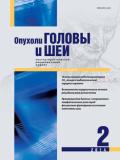Vol 5, No 2 (2015)
- Year: 2015
- Published: 08.06.2015
- Articles: 9
- URL: https://ogsh.abvpress.ru/jour/issue/view/14
DIAGNOSIS AND TREATMENT OF HEAD AND NECK TUMORS
Efficiency of radiotherapy during local hyperthermia in the treatment of laryngeal and laryngopharyngeal cancer
Abstract
 8-13
8-13


Microsurgical head and neck tissue repair by visceral mini-autografting
Abstract
Objective. To minimize surgical trauma in patients with head and neck tumors during microsurgical plasty with visceral autografts.
Subjects and methods. Clinical experience has been gained in the treatment of 53 patients with locally advanced craniofascial (n = 27) and oropharyngeal (n = 36) cancers. Abdominal organs were used for plastic closure of extensive defects after surgical resection. Paraumbilical incision allowing for an adequate approach into the abdominal cavity with minimal external trauma in the anterior abdominal wall was chosen as an access procedure. Video-assisted techniques were used to excise the midline aponeurosis. Donor organs, such as the omentum, greater curvature of the stomach, transverse colon, small intestine) were taken through a mini-laparotomic incision to the anterior abdominal wall, then the vascular pedicle was exposed and a visceral autograft was made. After forming and cutting off the autograft, organ anastomoses were created extracorporeally.
Results. Mini-access surgery could be completed in 50 of the 53 cases (4 patients had previously undergone abdominal interventions). Omental (n = 26), colo-omental (n = 15), gastro-omental (n = 7), and entero-omental (n = 5) flaps were made and prepared for autografting. No intra- or postoperative abdominal complications were found.
Conclusion. Minimally invasive technologies used to create visceral authografts for head and neck tissue repair can minimize surgical trauma and reduce treatment duration. The indications for this access are the debilitating state of a cancer patient or the young age of a patient who does not wish to have an additional scar in the donor region.
 14-19
14-19


Our experience with Russian voice prostheses long used in patents after laryngectomy with tracheoesophageal shunting and endoprosthesis replacement
Abstract
 20-24
20-24


ORIGINAL REPORTS
Investigation of the prognostic value of the apoptotic marker p53 gene and vascular endothelial growth factor in evaluating the clinical course of nasopharyngeal angiofibroma
Abstract
 25-29
25-29


LITERATURE REVIEW
New-generation mutitargeted tyrosine kinase inhibitors in the treatment of radioactive iodine-refractory differentiated thyroid cancer
Abstract
Background. Thyroid cancer (TC) is one of the common oncological disease of the head and neck. However, its treatment is sharply restricted in a locally advanced and metastatic cancer process. In the past decade, there have been fundamental changes in the understanding of the molecular bases of thyroid carcinogenesis, resulting in the design of novel targeted drugs aimed at disseminated and refractory TC control. Multikinase inhibitors that are able to block the processes of proliferation, invasion, and neoangiogenesis are being intensively studied worldwide. Performed placebo-controlled trials have culminated in the registration of the antitumor drugs that is highly active against disseminated medullary and differentiated TC, which will make a change in the situation in treating radioactive iodine-refractory differentiated TC in the near future.
Objective: to review recent advances in the targeted therapy of TC with particular emphasis on lenvatinib, a multikinase inhibitor.
 30-34
30-34


ORIGINAL ARTICLES
Investigation of quality of life in the treatment of locally advanced and recurrent oropharyngeal cancer: State-of the-art
Abstract
 35-38
35-38


Impact of oral hygiene on the development of oropharyngeal neoplasms
Abstract
 39-44
39-44


CASE REPORT
A clinical case of single-stage correction of penetration combined orofacial defect with two microsurgical autografts
Abstract
 45-54
45-54


CONFERENCES
 55-61
55-61












